Library of Congress's Blog, page 162
April 8, 2014
Library in the News: March 2014 Edition
March news headlines included a variety of stories about the Library of Congress. Of particular interest was a 10,000-item milestone – with the addition of a set of priceless manuscripts from the Walters Art Museum of Baltimore to the online Library-cosponsored World Digital Library, which now holds more than 10,000 items following its 2009 launch.
The Baltimore Sun and the Associated Press ran stories.
As a leader in audio-visual conservation, the Library continued to be spotlighted on its efforts in sound and film preservation.
“Ever since the first identifiable recording in 1860, sound has added captivating and significant context to history,” reported Emily Siner for National Public Radio. “The Library of Congress is one of thousands of institutions, large and small, trying to make sure that future historians — and even future archaeologists — have access to those recordings.”
The March/April issue of American Libraries Magazine highlighted institutions at the forefront of collecting and preserving films, including the Library, UCLA and The Louis B. Mayer Library at the American Film Institute (AFI) in Los Angeles.
“The declining state of America’s film heritage is a widely discussed topic among film industry professionals, film librarians, and archivists,” wrote Phil Morehart. “LC sits at the forefront of film preservation and collection.”
Also continuing the make news is the Library’s Carl Sagan collection. Writing a story for Cornell Alumni Magazine was Bill Sternberg, who who took Sagan’s Astronomy 102 class at the university in 1975.
“During his nearly three decades at Cornell, Carl Sagan became the best-known scientist on the planet. Unlike previous celebrity researchers, Sagan didn’t achieve fame from a singular breakthrough such as Jonas Salk’s polio vaccine or Albert Einstein’s general theory of relativity,” wrote Sternberg. “Sagan’s papers, open to the public at the Library of Congress since November, range over topics as majestic as outer space and as mundane as office space. (If you took Astronomy 102/104 in 1977, your grades are in Box 254.)”
From time to time, news outlets report on discoveries made within the Library’s Prints and Photographs collections – particularly when previously unidentified images receive biographical data that was unknown before. Recently, a Civil War tintype in the Library’s collection showing a group of Union soldiers was identified.
“Last month, a New York high school teacher spotted the photo on a Civil War Facebook page and recognized the image,” wrote Michael E. Ruane for The Washington Post. “Now the library, which has a digital version on its website, has names and stories to go with the faces.”
April 4, 2014
Collection Connections: “Twelve Years a Slave”
(The following is a guest post by Cheryl Fox, Library of Congress Archives collection specialist in the Manuscript Division.)
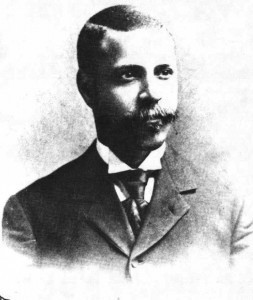
Daniel A. P. Murray (1852 -1925). Photographer unknown. Photograph, undated.
Solomon Northup’s account of his kidnapping in Washington, D.C., sale to a plantation owner in Louisiana and subsequent escape was first published in 1853, the year he regained his freedom. The Library of Congress Rare Book and Special Collections Division holds an 1859 edition of “Twelve Years a Slave,” which you can read about in this previous blog post.
Daniel A. P. Murray included the book in his 1900 bibliography, – a project he produced while working at the Library of Congress.
Murray, born in 1852 in Baltimore, worked at the Library from 1871 to 1925. U.S. Special Agent on Negro Education Thomas J. Calloway contacted then Librarian of Congress Herbert Putnam in January 1900 to request books or pamphlets written by African American authors for a display at the upcoming Exposition Universelle in Paris. Within a few months, Murray had compiled a preliminary list of 300 works. He credited former Librarian of Congress Ainsworth Spofford’s “amazing foresight” in collecting many of the books and pamphlets he found in the Library’s collection.
Murray also appealed to the public by traveling to African American communities, including Baltimore and Philadelphia, to find more books. He composed a letter that was printed and widely circulated, requesting materials or information that could be sent to the Library at no postage charge.
Murray’s list grew to 1,100 titles and became the core of the Library’s “Colored Authors’ Collection.”
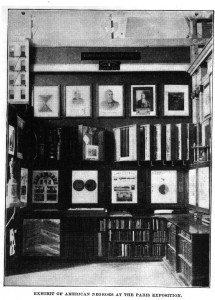
Exhibit of American Negroes at the Paris Exposition. Photographer unknown. Photograph undated, in Review of Reviews, vol. 22.
The Paris Exposition attracted more than 48 million visitors. Murray’s bibliography and several hundred books in the Palace of Social Economy were part of an exhibit curated by W.E.B. DuBois, “The American Negro.” Read more about the exhibit here.
W.E.B. DuBois paid special attention to Murray’s work in his description of the exhibit:
“Perhaps the most unique and striking exhibit is that of American Negro literature. The development of Negro thought – the view of themselves which these millions of freedmen have taken – is of intense psychological and practical interest. There are many who have scarcely heard of a Negro book, much less read one; still here is a bibliography made by the Library of Congress containing 1,400 titles of works written by Negroes; 200 of these books are exhibited on the shelves.” (Du Bois, W.E. Burghardt. 1900. “The American Negro at Paris.” The American Monthly Review of Reviews, vol.XXII, no.5 (November): pp.575-577. )
Judges for the Paris Exposition awarded the American Negro exhibit several medals; by popular demand, it was immediately sent on to the 1901 Pan American Exposition in Buffalo, N.Y.
After the Paris Exposition, the works collected by Murray and displayed in the exhibition were placed in the Library. At his death in 1925, Murray bequeathed his personal library of more than 1,400 volumes and pamphlets to the Library as well. The resulting collection of materials, many of them unique, provides a rich catalog of information on African-American life around the turn of the century.
In addition to the books and pamphlets Murray collected, portions of the “American Negro” exhibit W.E.B. Du Bois and special agent Thomas J. Calloway compiled are housed in the Prints and Photographs Division. A description of these materials is found here.
April 2, 2014
Someone Who Outdrew You
The Librarian of Congress and the National Recording Preservation Board have released this year’s choices for the prestigious National Recording Registry — and as always, it’s a veritable sonic smorgasbord of terrific stuff, from many genres. The selections are made to ensure the preservation for posterity of sound recordings with cultural, artistic or historical merit.
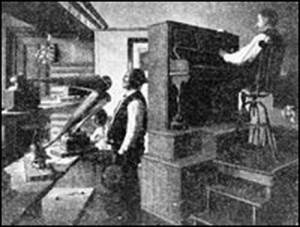
George Washington Johnson, recording
Some highlights:
The haunting Jeff Buckley version of Leonard Cohen’s “Hallelujah.” Buckley’s 1994 take is remarkable; the song itself has gone around the world several times, sung by its author, by John Cale, even by contestants on American Idol. Like many songs written by Cohen, it has arresting lyrics (“It goes like this – the fourth, the fifth – the minor fall, the major lift …”) Another verse notes, “All I ever learned from love was how to shoot at someone who outdrew you. “
“The Laughing Song” by George Washington Johnson, who in addition to having an infectious laugh that made his recording into a nationwide bestseller was a key figure in recording history as the first African-American recording artist. (You can hear this song, recorded in 1903, on the Library’s National Jukebox website.)
Art Blakey’s 1954 jazz album, “A Night at Birdland.”
Vol. 1 of Art Blakey’s “Night at Birdland”
Creedence Clearwater Revival’s 1969 song “Fortunate Son.” I remember smiling when I first took in this song’s opening lyric: “Some folks are born, made to wave the flag, ooh, they’re red white and blue! / And when the band plays ‘Hail to the Chief,’ ooh, they point the cannon at you! / It ain’t me – it ain’t me – I ain’t no senator’s son.”
Slide guitarist Elmore James’ 1951 version of the blues classic “Dust My Broom.” I defy you not to be moving around to the music, even if you’re sitting in a chair, by the fourth bar of this one.
The 1974 composer-conducted recording of Aaron Copland’s classical-music classic, “Appalachian Spring” (the musical component of a dance presentation choreographed by Martha Graham and premiered right here at the Library of Congress in 1944).
U2’s 1987 album “The Joshua Tree.”
Linda Ronstadt’s 1974 album “Heart Like A Wheel.”
Isaac Hayes’ 1971 soundtrack album, including the “Theme From Shaft,” now part of the vernacular.
The 1966 Carnegie Hall concert by Buck Owens and his Buckaroos.
The full list of 25 new selections, with background on all of the artists, is here.
You can, and should, nominate sound recordings (all kinds are eligible) to the National Recording Registry. To find out more, look here.
April 1, 2014
Trending: A Hallowed Legend
Nearly two centuries after its publication, “The Legend of Sleepy Hollow” is as popular as ever.
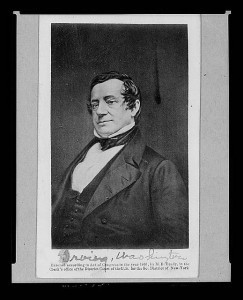
Washington Irving. 1861. Photo by Matthew Brady. Prints and Photographs Division.
Fox TV has a hit on its hands this season with its retelling of the 1820 short story “The Legend of Sleepy Hollow” by American author Washington Irving (1783-1859). The new drama series—one of many with supernatural themes—premiered Sept. 16, 2013, to 10 million viewers with 3.5 rating/9 share, making it the network’s highest rated fall drama premiere in the past eight seasons. Several weeks after the first episode aired, Fox renewed “Sleepy Hollow” for a second season.
Written while the itinerant Irving was living abroad in England, the popular tale was one of 34 essays and short stories—including “Rip Van Winkle”—comprising “The Sketch Book,” which Irving wrote under the pseudonym of “Geoffrey Crayon.”
One might argue that the post-Revolutionary- War tale of Connecticut schoolmaster Ichabod Crane and the dreaded Headless Horseman in the Dutch enclave in New York State known as Sleepy Hollow has never been far from the American imagination.
According to American University professor Lewis Grossman, the Headless Horseman has remained one of America’s favorite ghosts, in a roster that includes Casper, Freddie Kruger and Charles Dickens’ ghosts of Christmas. Grossman based his conclusion on his research in Google’s Ngram Viewer, a phrase-usage graphing tool that charts the yearly count of selected words and phrases. Grossman also used the tool to monitor the author’s popularity.
“The American-born Washington Irving was, at one time, more popular in England than Charles Dickens,” said Grossman, who spoke at the Library as part of American University’s “Books That Shaped America” lecture series. The series was inspired by the Library’s selection and exhibition of influential American works, including Irving’s ghost tale.
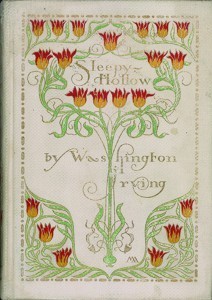
The Library’s Rare Book and Special Collections Division holds several copies of the first New York edition of “The Sketch Book” (1820). The division also holds eight 19th-century editions, including this 1899 edition featuring artwork by Margaret Armstrong (1867–1944), the pre-eminent designer of decorated cloth publishers’ bindings between 1890 and 1913.
“The Legend of Sleepy Hollow” was one of the first works of fiction by an American author to become popular outside of the United States. Regarded as the first American to earn a living by his pen, Irving argued for stronger laws to protect writers from copyright infringement. In the January 1840 issue of the New York literary magazine “Knickerbocker,” Irving endorsed legislation pending in the U.S. Congress that would offer stronger protection for American copyrights abroad. The copyright legislation was not enacted.
Long in the public domain, Irving’s tale has been immortalized on stage and film, most notably by Walt Disney in 1949 (with tunes sung by Bing Crosby) and 50 years later by director Tim Burton in his 1999 film starring Johnny Depp.
Located on the historic Hudson River, the real-life Sleepy Hollow remains a popular tourist destination, especially during Halloween. The town boasts Irving’s home (“Sunnyside”) and his gravesite in Sleepy Hollow Cemetery. Village administrator Anthony Giaccio recently reported a spike in visits to the town and its tourism website, which he attributes to the Fox show. Although the show is filmed in Wilmington, N.C., Giaccio hopes its popularity will do for Sleepy Hollow what the hit television series “The Office” did for Scranton, Pa.
This article, written by editor Audrey Fischer, is featured in the March-April 2014 issue of the Library of Congress Magazine, LCM, now available for download here. You can also view the archives of the Library’s former publication from 1993 to 2011.
March 27, 2014
A Millennium of Persian Literature
(The following is guest post by Mark Hartsell, editor of the Library of Congress staff newsletter, The Gazette.)
[image error]
“The Book of Shah Jahan” explores the life of the 17th-century ruler of India during whose reign the Taj Mahal was built. African and Middle Eastern Division.
Persian first gained prominence a thousand years ago, a language of literature, poetry and folklore that connected people across vast stretches of Asia, Eastern Europe and the Middle East.
The Library of Congress today opens “A Thousand Years of the Persian Book,” the first major U.S. exhibition to make such a wide-ranging study of the Persian language and literature. The landmark exhibition features 75 items drawn primarily from the Persian collection of the Library’s African and Middle Eastern Division, one of the most important such collections assembled outside of Iran.
“A Thousand Years of the Persian Book” will take visitors on a visual journey of the rich literary history of Persian language,” said Cynthia Wayne, a senior exhibits director in the Interpretive Programs Office. “Materials that will be on display have been rarely seen by the public. The show gives visitors an exciting opportunity to learn about the depth and breadth of the Library’s extensive Persian collections, which hopefully will lead to a greater understanding and appreciation of the important contributions of Persian literary achievements.”
The exhibition is made possible through the support of the Public Affairs Alliance of Iranian Americans, former Iranian Ambassador to the United States Hushang Ansary, Jawad Kamel, Nazie Eftekhari and other donors.

Twentieth-century religious text shows the Farvahar, a man and winged disc that symbolize the Zoroastrian faith. African and Middle Eastern Division.
The Library marks the opening — timed to coincide with the Persian new year season of Nowruz — with a lecture and panel discussion about Persian manuscripts and the tradition of manuscript-making in Persian-speaking lands. Those programs kick off a lecture series of 13 events, hosted by the Library and the Roshan Institute for Persian Studies at the University of Maryland, that explore aspects of Persian literature. The series is made possible by the Roshan Cultural Heritage Institute in Hawaii.
Persian gained prominence as a common cultural language across Central and South Asia and parts of the Middle East about 1,000 years ago. Just as French at one time served as the common language for educated elites across Europe, so Persian served as the preferred tongue for writers of literature and history from what is now Turkey to India.
“Persian had a similar role: It was a language of poetry and history,” said curator Hirad Dinavari of the African and Middle Eastern Division. “Persianate courts taught Arabic for religious material, for science, for philosophy. But Persian was often used for literature and history.”
The exhibition opens and closes with the seminal work of Persian literature: the “Shahnameh,” an epic 10th-century tale of kings, heroes and devils told in 50,000 rhyming couplets that took poet Ferdowsi 33 years to complete.
“‘Shahnameh’ is our ‘Iliad’ and ‘Odyssey,’” Dinavari said. “It shows the world the legacy of the Persian kings and civilizations. All stories come from the pre-Islamic era – the era of Cyrus and Darius and the ancient kings.”
In between early and modern versions of “Shahnameh,” the exhibition explores works of religion, science, modern literature, children’s books, women’s literature and the highly illustrated masterpieces of classical poetry for which Persian literature is most famous. From the 10th through the 16th centuries, poets such as Omar Khayyám, Rumi and Sa’di produced works that resonated down through the ages.
Shahnameh, or “Book of Kings.” African and Middle Eastern Division.
“The Moving Finger writes: and, having writ, Moves on: nor all thy Piety nor Wit Shall lure it back to cancel half a Line, Nor all thy Tears wash out a Word of it,” Khayyám wrote in “Rubaiyat,” a work that centuries later still would inspire artists from Eugene O’Neill to Agatha Christie, from Woody Guthrie to Van Morrison.
Persian has evolved somewhat over the centuries, Dinavari said, but not so much that it can’t be easily understood today – as might be the case with Shakespearean English. Thus, Persian speakers still can appreciate the words of the poet Rumi as readily as his 13th-century audience: “Out beyond ideas of wrongdoing and rightdoing there is a field. I’ll meet you there.”
The language of Rumi, Khayyám and Ferdowsi served, and still serves, as a unifying cultural force in a vast region of many faiths, ethnicities and ideas.
“You had these amazing crossroads, philosophically and religiously,” Dinavari said. “That adds to the richness.”
March 26, 2014
Celebrating Creative Women: Rare and Special Collections
I am obnoxious to each carping tongue
Who says my hand a needle better fits,
A Poets pen all scorn I should thus wrong,
For such despite they cast on Female wits:
If what I do prove well, it won’t advance,
They’l say it’s stoln, or else it was by chance.
– Anne Bradstreet, 1678
Anne Bradstreet (1613-1672), the first woman poet to be published in America, was praised by many of her male contemporaries for her work addressing home and family, philosophy, religion and sensitivity to prejudices against women’s writings. Her poetry collection, “The Tenth Muse Lately Sprung Up in America,” was showcased recently during a special display hosted by the Library’s Rare Book and Special Collections Division that highlighted creative women and celebrated Women’s History Month.

Rare, duodecimo first printing of the Report of the Woman’s Rights Convention. 1848. Rare Book and Special Collections Division. Photo by Shealah Craighead.
Curators exhibited items from the 16th through the 21st centuries, illustrating several areas of strength in the division, including the domestic role of women, reform efforts, women in popular culture, literary works and collections formed by women.
American History Specialist Rosemary Plakas arranged the intimate exhibit, calling on her more than 40 years experience working with the collections. During a quick walkthrough, she pinpointed some items of interest. One of her favorites is the Susan B. Anthony collection.
“In 1903, she gave to the Library of Congress her personal library, including abolitionist materials, speeches, suffrage scrapbooks,” said Plakas. “She wrote annotations in all her books.”
On display was her annotated copy of the printed transcript of her trial for illegally voting in the 1872 presidential and congressional election. The volume documents Anthony’s efforts in testing the citizenship clause of the Fourteenth Amendment. Anthony was found guilty, although not by jury. The federal judge had made his decision before even hearing the case.
Also on display was one of seven scrapbooks from the National American Woman Suffrage Association Collection. Between 1897 and 1911 Elizabeth Smith Miller and her daughter, Anne Fitzhugh Miller, filled seven large scrapbooks with ephemera and memorabilia related to their work with the Geneva Political Equality Club, which they founded.
“You turn the pages and you never know what you might find,” Plakas said of the scrapbooks. “Teachers really use the material.”
Of particular note is a rare copy of a report from the first women’s rights convention, held at Seneca Falls, N.Y., in 1848.

Cigar label art featuring women. Rare Book and Special Collections Division. Photo by Shealah Craighead.
From the Copyright Deposit Collection was a selection of advertisements featuring women in cigar label art. Cigar smoking was popular during the 1870s, and women were often a favorite subject. With women’s suffrage such a hot button issue of the time, these ads capitalized on the resulting fear. In these ads, women can be seen smoking while voting and taking men’s jobs, as well as in the use of the brand name “Sixteenth Amendment,” which was expected to be the woman suffrage amendment in 1870.
Highlighting women as collectors, Plakas pointed out items from the Marian S. Carson Collection. Her interest in children’s literature brought to the Library some 300 early and rare books, games and amusements printed during the first half of the 19th century. On display was “The Diligent Girl as Lady of the House,” an “amusing game for good girls,” that gives a glimpse into the upper class family household.
[image error]
“The Diligent Girl as Lady of the House.” Ca. 1870s. Rare Book and Special Collections Division. Photo by Shealah Craighead.
The display was also particularly strong in items relating to the culinary arts and the household. Sixteenth century needlework designs joined a 17th century Japanese text on carving, with intricate block print illustrations depicting methods of preparing fish and fowl.
[image error]
“Manner of Cookery,” Ryori Shitsuke-sho. 1642. Rare Book and Special Collections Division. Photo by Shealah Craighead.
While the Rare Book and Special Collections Division is strong in its holdings related to women’s history, they complement materials from across the Library of Congress, which are some of the finest and most comprehensive anywhere.
March 24, 2014
Where Literacy Lives (And Doesn’t)
(The following is a guest post by Guy Lamolinara, communications officer in the Center for the Book in the Library of Congress.)
The number of organizations dedicated to eradicating illiteracy, raising time spent reading and increasing reading proficiency is legion because the problems are legion. These groups can be found throughout the world, including the United States, which, despite its immense wealth, is not immune to reading deficiencies among its people.
With that in mind, David M. Rubenstein established the Library of Congress Literacy Awards in 2013. Rubenstein is co-founder of The Carlyle Group and the sponsor of these awards, as well as the primary donor to the Library’s National Book Festival.
Last year, three longtime organizations won awards totaling $250,000 to enable them to continue the exemplary work they are doing to promote reading.
Reach Out and Read won the Rubenstein Prize of $150,000 in recognition of its successful program to enlist pediatricians in encouraging reading by offering free books and basic literacy awareness advice to parents as part of their children’s visits.
The American Prize of $50,000 went to 826 National, which has opened “literacy stores” in eight U.S. cities to address community reading problems.
PlanetRead in India received the $50,000 International Prize for its innovative program of adding subtitles to musical television programs in India, where access to TV is more widespread than access to books.
Award applications last year came from 187 organizations based in 28 U.S. states and 21 nations. The “Best Practices” of 26 of these groups are available in a publication whose intent is to encourage other organizations to emulate these practices.
The 2014 Literacy Awards cycle is about to close, but there is still time to submit an application. Just follow the simple instructions, which require a 750-word essay and two letters of recommendation. Applications are due by midnight March 31, 2014, Eastern Daylight Time.
March 20, 2014
Celebrating Women: On Your Mark! Get Set! Mush!

Iditarod Trail Portage Shelter Cabin, Golovin, Nome Census Area, Alaska. Prints and Photographs Division.
On this day in 1985, at 9 a.m., Libby Riddles became the first woman to win the Iditarod Trail Sled Dog Race. She finished in 18 days, 20 minutes and 17 seconds. March is Women’s History Month, and this year’s theme is “Celebrating Women of Character, Courage and Commitment.” Riddles certainly fits that bill.
Often called the “last great race on earth,” the race covers more than 1,000 miles of beautifully rugged yet harsh terrain in Alaska, from Anchorage to Nome. Add below zero temperatures and other hazards, and you’ve got quite a Herculean feat.
A musher (term used to indicate a person who competes in cross-country races with a dog team and sled) since 1976, Riddles has actually placed in the Iditarod five times, finishing in the top 20 all but once. A Wisconsin native, Riddles moved to Alaska when she was 17. She fell in love with sled dogs but really had no intention of racing. According to Riddles, thanks to a push by a friend, she entered into a small five-dog race and won first place. The seed was then planted, which led Riddles to breed her own sled dogs and ultimately take first place at the 1985 Iditarod.
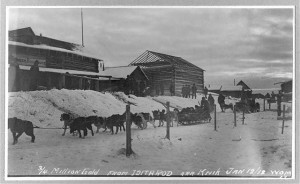
Dog sled arriving from Iditarod. Jan. 12, 1912. Prints and Photographs Division.
In addition to the Iditarod, Riddles has raced many different mid-distance races and participated in the European Alpirod (now defunct) several times, as well as the International Rocky Mountain Stage Stop Sled Dog Race. She has written several books, is a professional speaker and still raises champion sled dogs.
You can read more on the Iditarod here, which includes links to photographs of the race route and related resources to Alaskan history and culture.
The Library of Congress is an incomparable resource for research into women’s history and studies. Visit www.womenshistorymonth.gov to view some of those collections.
March 18, 2014
Where Poetry Lives
The Library of Congress’s poetry blog, From the Catbird Seat,” has run a few posts on Poet Laureate Natasha Trethewey’s second-term project, “Where Poetry Lives.” For her project, Trethewey has joined NewsHour Senior Correspondent Jeffrey Brown for a series of on-location reports in various cities across the United States to explore several large societal issues, through a focused lens offered by poetry and her own coming-to-the-art.
According to Robert Casper, head of the Library’s Poetry and Literature Center, “‘Where Poetry Lives,’ has offered her the opportunity to see first-hand how poetry strengthens our communities. She has travelled from coast-to-coast and met people from different backgrounds and at different parts of their lives, all of whom connected to her and to each other through the art.”
Since September of last year, Trethewey has traveled to Brooklyn to spend time with the Alzheimer’s Poetry Project, to Detroit to visit Motor City middle-schoolers and to Boston for a reading and writing workshop for medical students, among others.
Now all of the content from the series—the segments themselves as well as additional content the NewsHour staff have created—lives on one website. Visit “Where Poetry Lives” to watch all related content.
And, make sure to check out Casper’s blog posts on the series and some of his experiences traveling with the Poet Laureate to produce some of the segments: On the First NewHour Segment with the Poet Laureate, Tune In Tonight! and Finding “Where Poetry Lives.”
March 13, 2014
Celebrating Women’s History: Still Standing – The Story of Tammy Duckworth
(The following is a guest post by Lisa A. Taylor, liaison specialist with the Veterans History Project.)
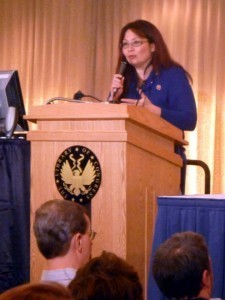
Tammy Duckworth speaking at the Library of Congress. Photo by Christy Chason.
Disabled combat hero, veterans’ advocate, politician, woman. U.S. Rep. Tammy Duckworth (D-Ill.) is many things, most strikingly, a person who has not only survived but thrived. Her story is among thousands of other women veterans’ stories in the Veterans History Project (VHP) collections.
I had a chance to hear some of her story this past November, during the U.S. Department of Health and Human Services’ (HHS) Annual Salute to Veterans.
Duckworth was a member of the Illinois Army National Guard when she was deployed to Iraq in 2004. During her VHP interview, which was recorded in 2010, Duckworth said, “When I got to Iraq, my world focused in on one mission. It was incredibly rewarding.”
As a Blackhawk helicopter pilot, Duckworth was one of the first Army women to fly combat missions during Operation Iraqi Freedom. Eleven months into her tour, Duckworth’s helicopter was hit by a rocket-propelled grenade (RPG), which shot through the floor of the aircraft and exploded, causing her to lose both legs and partial use of her right arm. But she survived. Passing in and out of consciousness, Duckworth relied on her training to stay alive.
“You fly. You aviate. You do everything you can to get the aircraft safely on the ground.”
And that is just what she and her co-pilot did.
“I should have bled out in about four or five minutes. To this day, they’re not sure why I didn’t bleed out, other than maybe the blast actually cauterized my wounds a little bit.”
Duckworth was later awarded a Purple Heart for her combat injuries. And she thrived. Duckworth declined a military medical retirement and continues to drill as a Lieutenant Colonel in the Illinois Army National Guard.
Duckworth spent the next year recovering from her injuries at Walter Reed Army Medical Center in Washington, D.C.
“I was the highest ranking amputee at Walter Reed at the time, and because of that, I became sort of a spokesperson for wounded warriors.”
That experience was the spark that lit the flame for her to seek a Congressional seat in 2006. Although she lost that election, she was appointed the director of the Illinois Department of Veterans Affairs and later assistant secretary of Veterans Affairs. During her tenure, Duckworth was able to create a tax credit for Illinois employers who hired veterans and to establish a first-in-the-nation 24/7 crisis hotline for veterans. She also pushed initiatives to end homelessness among veterans and programs to help Native American and female veterans. In 2012, Duckworth ran for Congress and won the democratic seat for Illinois’ 8th District where she continues to be an advocate for veterans.
As the HHS emcee was reading her introduction, Duckworth headed for the Great Hall stage via a back-stage wheelchair ramp. My first thought was that someone on the HHS event committee had goofed. The podium and microphone were positioned at standard height. “How could they forget to make reasonable accommodations for the keynote speaker?” I thought. Then Tammy Duckworth proved me wrong. She rolled right up to the podium, locked the wheelchair’s wheels, pulled herself to a standing position and gave one of the most inspirational speeches I have ever witnessed.
Duckworth had not come to HHS to recount her harrowing tale of surviving an RPG explosion or the phantom pains she often experiences since losing her limbs. She was not there to tick off a checklist of her accomplishments or to advocate for wounded warriors. She was simply there to talk to a room full of her peers – military veterans who happen to be federal employees – about how critical they are to the function, and very survival, of the nation. She wanted them to know that their hard work and dedication was not overlooked. From the looks on their faces, that seemed to be all they needed to hear.
Visit the Veterans History Project Website at www.loc.gov/vets/ to view Tammy Duckworth’s VHP interview and access more than 90,000 other veterans’ stories, including several features on women in wartime: Women at War, Women of Four Wars and The WASP: First in Flight.
March marks Women’s History Month, and the Library of Congress is an incomparable resource for research into women’s history and studies. Visit www.womenshistorymonth.gov to view some of those collections.
Library of Congress's Blog
- Library of Congress's profile
- 74 followers



